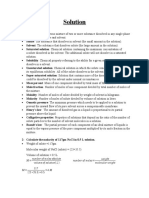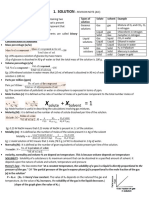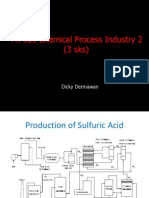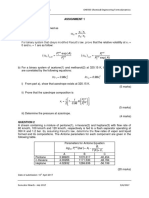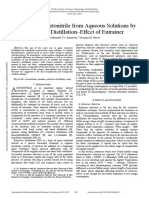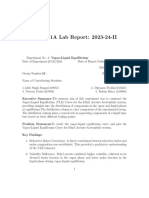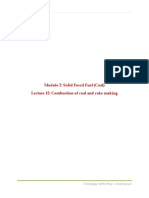Solution
❖ Defination
1. Colligative
➢ Those properties which depends on number of ions or solute particles or species but do not
depend on composition.
2. I factors
➢ The van 't Hoff factor i is a measure of the effect of a solute on colligative properties such as
osmotic pressure, relative lowering in vapor pressure, boiling-point elevation and freezing-point
normal molar mass
depression. i = abnormal molar mass
3. Reverse osmosis.
➢ Reverse osmosis is the process or the technology which is used to remove ions, mineral chemicals,
and other impurities from drinking water.
4. Osmotic pressure
➢ Osmotic pressure is the minimum amount of pressure needed to prevent a solvent from moving
through a semipermeable membrane from a less concentrated solution to a more concentrated
solution
5. Azeotropes .
➢ It is a binary mixtures whose composition is same in liquid and vapour phase same at boil a
constant temperature phase .
6. Minimum boiling azeotropes.
➢ The solution which slow large positive deviation rault’s law .
Eg :-- eathnol water mixture
7. Maximum boiling azeotropes.
➢ The solution which show large negative deviation rault’s law
8. Abnormal molar mass .
➢ The molar mass which Is either lower or higher than than the accepted or normal value is known as
abnormal molar mass this is due to association or disassociation of compounds .
❖ Law
1. Henry law
➢ The Partial pressure of the gas in vapour phase (p) is proportional to the mole fraction of the gas (X)
in n the solution
P=KhX (P∝ Xgas)
▪ Application of Henry law :------
➢ Soft drink, cold drink or bear are sealed under high pressure show that the disassociation of CO2 is
maximum.
➢ At high altitude the partial pressure of oxygen is less than that at the ground level . This leads to low
contraction of oxygen in the blood and tissue of people living at high altitude or climber . Low blood
oxygen cause climber to become weak and unable to think clearly, symptoms of a condition known
as anoxia
1
� ➢ The marine divers are suffer from disease like bends because due to increase in pressure in depth
the dissolvation oxygen in blood also increase
▪ Limitation:-----
➢ It do not apply when temperature and pressure is too high and too low .
▪ Effect of temperature :-----
➢ On increasing temperature the solubility of gas in liquid is decrease. (T↑ , S↓)
▪ Effect of pressure:-----
➢ On increasing pressure of the solubility of gas in liquid also increase ( P ↑ , S↑ )
2. Rault’s law
➢ For a solution of volatile liquid the partial pressure of each component of the solution is directly
proportional to its mole fraction in the solution.
PA∝XA. PB∝XB
PA=P°A XA PB=P°B XB
Doltons law
Ptotal = PA + PB + …….. + PN.
Ptotal = PA + PB
Ptotal = P°A XA + P°B XB
❖ Some very important questions :--
1. Give difference between ideal and non ideal solution [CBSE 2023]
Ideal Non – Ideal
Which obey rault’s law at wide range Which do not obey Raults law at wide
of concentration range of concentration
PA=P°A XA , PB=P°B XB PA≠ P°A XA , PB ≠ P°B XB
∆H = 0. ∆H ≠ 0
∆Vmixing = 0 ∆Vmixing ≠ 0
FA-FA = FB-FB = FA-FB FA-FA ≠ FB-FB ≠ FA-FB
Ex :- hexane + heplane
Ex :- water + nitric acid
Bromoethane+ choroethane
Alcohol + water
Benzene to toloune
2. Give difference between positive and negative diviation .
Positive diviation Negative diviation
PA>P°A XA PA<P°A XA
∆H > 0 ∆H < 0
∆Vmixing > 0 ∆Vmixing < 0
Ex :- water + alcohol Ex :- water + nitric acid
❖ Solution
1. Solid in liquid
• Effect of temperature
2
� On increasing temperature the solubility in solid is also increase (T↑ , S↑ )
• Effect of pressure :-- no effect
2. Liquid in liquid
3. Gas in liquid
• Effect of temperature:-- On increasing temperature the solubility of gas in liquid is decrease .
• Effect of pressure:-- On increasing of pressure the solubility of gas in liquid is also increase.
❖ Some important formula :--
• ∆Tb = Tb – Tb° . • π = CRT
• ∆Tb = KbM.
1000×w2×Kb w
• M2 = •M2 = π×V × RT
∆Tb ×w1
K𝑓 ×w2 ×1000
• M2 = ∆Tf×w1
❖ Numerical questions :--
1. Calculate the molarity of a solution containing 5g of NaOH in 450 mL solution.
5g
➢ Moles of NaOH = 40g = 0.125 mole
Volume of the solution in litres = 450mL / 1000mL L-1
𝑚𝑜𝑙𝑒𝑠 𝑜𝑓 𝑠𝑜𝑙𝑢𝑡𝑒 0.125 mol×1000mL
Molarity = volume of soloution in litre = = 0.278 M
450mL
2. Calculate the mass percentage of benzene and carbon tetra chloride (CCl4) if 22g of benzene is
dissolved in 122g of carbon tetrachloride .
➢ Total mass of solution= 22g +122g = 144g
22
Mass % of CCl4 = 144 × 100 = 15.28%
122
Mass % of benzene = 144 × 100 = 84.72 %
3. Calculate the mole fraction of benzene in solution containing 30% by mass in carbon
tetrachloride.
➢ Mass of benzene = 30g
30
Moles of benzene = 78 = 0.385 mol
Mass of CCl4 = 70g
70
Moles of CCl4 = = 0.454
154
mole of benzene 0.385
Xbenzene = moles of benzene+moles of carbon tetrachloride = 0.385+0.454 = 0.459
XCCl4 = 1- 0.459 = 0.541
4. Calculate the molarity of each of the following solution (a) 30g of Co(NO3)2•6H2O in 4.3 L of
solution. (b) 30 mL of 0.5 M H2SO4 dilute to 500 mL
➢ Molar mass Co(NO3)2•6H2O = 290.93
30
Moles of Co(NO3)2•6H2O = 290.93 = 0.103
0.103
Molarity = = 0.024 𝑀
4.3
3
� ➢ B:-- Solution
Given that ,
M1 = 0.5 mol , V1 = 30 mL , V2 = 500ml , M2 ?
M1V1 = M2V2
0.5 × 30 = M2 × 500
0.5×30 15
M2 = = 500 = 0.03
500
5. Calculate the mass of urea mass of urea required in making 2.5 kg of 0.25 molal aqueous solution.
➢ Mole = 0.25
Molar mass = 60g
15.25 × 60g = 15 g
15 g in 1kg
2.5kg = ?
2.5kg × 15 = 37.5 g
6. Calculate (a) molality (b) molarity and (c) mole fraction of KI if the density of 20% (mass/mass)
aqueous KI is 1.202 g mL-1
➢ 20 % of KI means 20g of KI are present in 100g of solution or 80g of water ?
Mass of KI = 20g
Molar mass of KI = 166
20
Moles of KI = 166 = 0.120
0.120
(A,)molality = 0.080 = 1.5
0.120 𝑚𝑜𝑙
(B) Molarity = = 1.2 mol /L
0.100 L
(C) moles of KI = 0.120
Moles of water = 80 / 18 = 4.44
0.120
XKI = 4.44+0.120 = 0.0263
7. Henry’s law constant for CO2 in water Is 1.67 × 108 Pa at 298K . Calculate the quantity of CO2 in 500
mL of soda water when packed under 2.5 atm CO2 pressure at 298 K.
➢ KH = 1.67 × 108 Pa
P = 2.5 atm = 2.5 × 101.325 × 103 Pa
= 2.533 × 105 Pa
P= KHXCO2
P 2.533×105
XCO2 = K = Pa = 1.517 × 10−3
h 1.67×108
500
Moles of water = = 27.78
18
𝑛2 𝑛
X2 = 𝑛 = 1.517 × 10-3 = 27.78+𝑛
2
1 +𝑛2 2
n2 = (27.78+n2) 1.517 × 10 -3
n2 = 0.0419 + 0.0015 n2
0.9985 n2 = 0.0419
n2 = 0.0420
Ammount of CO2 dissolved = 0.0420 × 44 = 1.85 g.
4
�8. 200 cm3 of an aqueous solution of a protein contain 1.26g of the protein. The osmotic pressure of
such a solution at 300 K is found to be 2.57 × 10-3 bar . Calculate the molar mass of the protein
➢ The various quantities known to us are as follows: π = 2.57× 10-3 bar ,
V = 200 cm3 = 0.200 litre
T = 300 K
R = 0.083 L bar mol-1K-1
𝑤2 ×𝑅𝑇 1.26g×0.083 L bar K−1 mol −1 ×300K
M2 = = = 61,022 g mol−1
𝜋×𝑉 2.57×10−3 bar ×0.200L
9. Vapour pressure of pure water at 298 K is 23.8 mm Hg . 50 g of urea is dissolved in 850g of water .
Calculate the vapour pressure of water for this solution and its relative lowering .
➢ Given that ,:- 50g urea , 850g , water
50g
Moles of urea = 60gmol−1 = 0.83 mol
850g
Moles of water = 18mol−1 = 47.22 mol
moles of urea 0.83 0.83
Xurea =moles of urea+moles of water = 0.83+47.22 = 48.5 = 0.01
Formulla
P°−P 23.8−P
XB = = = 0.01
P° 23.8
PA = 23.8 – (0.01 × 23.8)
PA = 23.8 – 0.238 = 23.562
10. Boiling point of water at 750 mm Hg is 99.63° C . How much sucrose is to be added to 500g of water
such that it boils at 100°C .
➢ Given :- Tb = 100°C , T°b = 99.63°C , Kb = 0.522 , Mb = 342 , w1 = 500g
∆Tb = Tb – T°b = 100 – 99.63 = 0.37°C
Kb ×1000×Wb 342×500×0.37 95×37
Mb = = = = 121.21
w1 ×∆Tb 0.522×1000 29
11. Calculate the mass of ascorbic acid (vitamin C , C6H8O6) to be dissolved in 75g of acetic acid to
lower it’s melting point by 1.5°C . Kf = 3.9 K kg mol-1
➢ ∆T = 1.5°
K𝑓 ×1000×Wb
M= W_1 ×∆Tf
3.9×1000×𝑊𝑏
176= 75×1.5
(176×75×1.5)
Wb = = 𝟓. 𝟎𝟖𝐠
3.9×1000
12. Calculate the osmotic pressure in Pascals exerted by a solution prepared by dissolving 1.0 g of
polymer of molar mass 185,000 in 450 mL of water at 37°C .
𝑛
➢ π = cRT = V RT
1.0
n =185000
V= 450mL
T = 273+37= 310 K
R = 8.314 × 103 Pa L mol-1 K-1
1.0×8.314×103×310
Ππ= 450 = 30.96Pa
185000×1000
5
�13. 19.5 g of CH2FCOOH is dissolved in 500g of water . The depression in the freezing point of water
observed is 1.0°C . Calculate the Van’t Hoff factor and dissociation constants of fluoroacetic acid
➢ Molecular mass of CH2FCOOH = 78
𝟏𝟗.𝟓
Moles of CH2FCOOH = = 0.25
78
0.25×1000
Molality = = 0.50 𝑚
500
∆Tf = Kf × m
= 1.86 × 0.50 = 0.93 K
observed freezing point depression 1.0
Van’t Hoff factor = Calculated freezing point depression = 0.93 = 1.0753
CH2FCOOH dissociate as :
CH2FCOOH CH2FCOO- + H+
Initial conc. M 0 0
After dissociation m(1- a ) ma ma
(a is the the degree of dissociation)
Total number of moles = m(1 - a) + ma + ma = m(1 + a)
m(1+a)
I= = 1 + a = 1.0753
m
A = 1.0753 – 1 = 0.0753
[CH2FCOO- ] = ma = 0.50 × 0.0753 = 0.03765
[H+] = ma = 0.50 × 0.0753 = 0.03765
[CH3COOH] = m(1 – a)
= 0.50 (1 – 0.0753) = 0.462
[CH2 FCOO − ][H+ ] (0.3765)×(0.03765)
Ka = [CH2 FCOOH]
= = 𝟑. 𝟎𝟕 × 𝟏𝟎−𝟑
0.462
14. Vapour pressure of water at 293 K is 17.535 mm Hg . Calculate the vapour pressure of water at 293
K when 25 g of glucose is dissolved in 450 g of water.
P°−P) w MA
➢ = x2 ≈ M B
P° B WA
17.535 − 𝑝 25 × 18
=
17.535 180 × 450
17.535 − 𝑝
= 5.56 × 10−3
17.535
17.535 − p = 0.0975
p = 17.438 mm Hg
15. 100 g of liquid A (molar mass 140g mol-1) was dissolved in 1000g of liquid B (molar mass 180g mol-1)
The vapour pressure of pure liquid B was found to be 500 torr . Calculate the vapour pressure of
pure liquid A and its vapour pressure in the solution if the total vapour pressure of the solution is
475 torr.
100
➢ Moles of A = 140 = 0.714
1000
Moles of B = = 5.556
180
0.714
Mole Fraction of A = = 0.114
0.714+5.556
Mole fraction of B = 1 – 0.114 = 0.886
ptotal = 𝑝𝐴 + 𝑝𝐵 = 𝑝𝐴 °𝑥𝐴 + 𝑝𝐵 °𝑥𝐵
6
� 475 = pA° × 0.114 + 500 × 0.886
475 = 0.114 pA° + 443
0.114 pA° = 32
pA° = 280.7 torr
Vapour pressure of pure A = 280.7 torr
Vapour pressure of A in solution= 280.7 × 0.114 = 32 torr



























